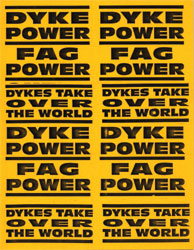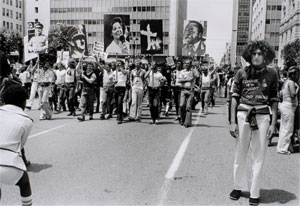
ACT UP San Francisco
Stickers, c.1990
The phrase "the personal is political" was first employed in the women’s rights movement.
Over time the meaning broadened to include the concept that personal choice directly affects
political systems and social structures. Some people’s life choices require that they diverge
from social norms, shifting their personal and professional lives into the political sphere.
An outstanding example of LGBT forthrightness is contained in the “coming out” letter that
Republican party strategist and fundraiser Marvin Liebman published in the politically
conservative National Review. He later wrote the book Coming Out Conservative, which
describes his life as a gay man. The creation of untraditional families is one example of social
politics at work; by pursuing life on their own terms, such families are engaged in a form of
activism. In the groundbreaking documentary Word Is Out, Peter Adair interviewed members
of the LGBT community; his artistic editing highlighted the commonalities between their
experiences.
Throughout history, LGBT people have questioned social roles, recognizing that their experience does not mirror that of the status quo, or the majority. Deeply committed to personal and social change, they made difficult decisions, often in isolation, to make a difference in their communities. William Billings, arrested and imprisoned in 1954 for "indecent acts," fought for his civil rights, ultimately obtaining a pardon from the governor of Colorado. Magnus Hirschfeld’s pioneering work in the early part of the twentieth century sought to educate scientists and legal officials on the complexities of human sexuality. Like Harry Hay and others who later contributed to shaping modern gay identity, Magnus Hirschfeld was drawn to the cultural experience of indigenous people—cultures that traditionally celebrate rather than pathologize diverse ways of being.
Magnus Hirschfeld and his Institute for Sexual Science were leaders in the study of sexuality in Berlin in the 1920s and 1930s. Hirschfeld and his Scientific Humanitarian Committee (founded in 1897) worked to remove Paragraph 175—the portion that forbade sex between men—from German law. Ultimately their efforts were unsuccessful. In contrast to the egalitarian and liberal ideology of the Scientific Humanitarian Committee, the journal Der Eigene, which began in 1896, advocated a more patriarchal and conservative approach, even though it also emphasized same-sex relationships. With the rise of the Nazi party, Hirschfeld, an openly homosexual Jew, was forced to flee Germany. The events of that time are the subject of Rob Epstein’s film Paragraph 175. In light of Hirschfeld’s life and exile, the artist Cathy Cade’s documentary photographs are especially evocative. So, too, is William Billings’s scrapbook documenting his incarceration for being gay. The way in which Billings assembled his obsessive and revealing visual journals is an inspirational, intricate collage.

Cathy Cade
Commie, Faggot, Queer and Proud
1977
Gelatin silver print
CATHY CADE PHOTOGRAPHS COLLECTION
The 1930s El Dorado tokens, which, historians believe were meant to be exchanged for a dance with
a transvestite in the Weimar-era club, are a lasting reminder of a liberal and liberating era. Daniel
Nicoletta’s photograph of the dressing room at Finocchio’s on its last night of business documents a
significant event in San Francisco’s LGBT history and presents a poignant counterpoint to the tokens.
The lives of LGBT people often take unexpected turns leading to more public arenas. Harvey Milk was
one such man—a gay small business owner (Milk owned a camera shop in San Francisco’s Castro
neighborhood) who changed the nation’s political landscape by holding civic office as an openly gay
man. Milk saw politics as the most efficient means of fighting bigotry and enacting the social changes
that he and many others saw necessary. And like others before him, Harvey Milk understood the risk
that he was taking by being open and out.
In the 1980s the advent of AIDS required a new level of political activism and awareness, and in the midst of a catastrophic health crisis, an extraordinary collective response unfolded. Organizations such as ACT UP (the AIDS Coalition to Unleash Power), Queer Nation, and OutRage! shared a commitment to direct action—speaking out against the homophobia pervasive in our communities, government, the health system, schools and the media. The great energy, creativity and political vision of dedicated grassroots activists found expression in the bold graphics and powerful language of the posters, stickers, flyers and newsletters that were produced and distributed in New York, San Francisco and many other cities worldwide.
AIDS and its devastating personal and communal effects are the subjects of Rob Epstein and Jeffrey Friedman’s film Common Threads and Randy Shilts’ book And the Band Played On. The material from Ward 86 (later Ward 5B/5A) documents activity at San Francisco General Hospital’s AIDS ward—on the cutting edge of AIDS treatment in the nation. Collected by the nurses as well as patients and family members, the Ward 5B/5A material complements many of the other items in the archives by detailing institutional concerns and practices as well as personal narratives and community responses. The archives contains photographs that reveal the reality of AIDS within the personal and private realms of hospitals. One such photograph by Rick Gerharter depicts Rita Rocket, who initiated a weekly brunch for AIDS patients and their friends and families. Such photographs make a connection between the isolation of illness and the impact of HIV/AIDS on the broader community. Amongst the papers of J. Allen Carson, a member of San Francsco’s ACT UP, Queer Nation and OutRage!, are many examples of the brilliant graphic materials created by activist organizations in the 1980s and early 1990s, which speak to the passionate and dedicated efforts of the LGBT community in the fight against all forms of discrimination.
The debate over the appropriateness of gays in the military has raged for decades—with many courageous men and women coming out in the armed forces, refusing to hide their identity because of their country’s small-mindedness. And most recently, the movement to legalize gay marriage has both intensified and expanded, bringing this fundamental civil rights issue to the forefront of the nation’s consciousness. All of these stories demonstrate individuals redefining their relationship to society, risking their lives to change the world.

